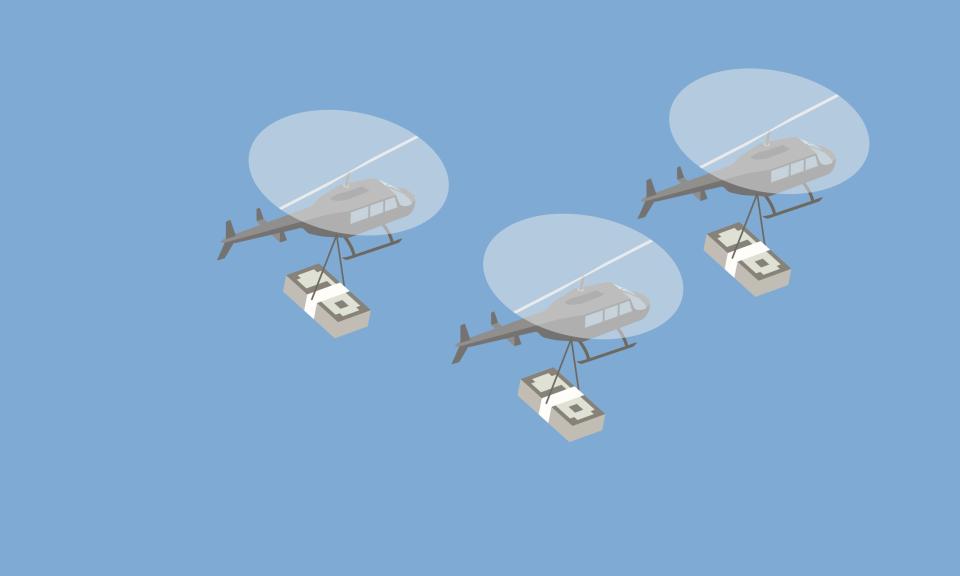Central banks are buying huge quantities of government bonds, but these aren’t “printing money” or “helicopter drops”, they are helping in greatly stabilising the economy
The scale of extra government spending needed to prevent the COVID-19 pandemic from doing lasting economic harm is enormous. Public sector liabilities will rise greatly, just as they did for many countries after the Napoleonic, and First and Second World Wars. But those liabilities relative to our national income can come down again after we get through this crisis – just as they did after those huge wars in the 19th and 20th centuries.
But it would not be surprising if there were difficulties for bond markets in digesting the scale of government debt issuance needed in a short period to fund such extra spending. It would then be entirely appropriate for the central bank to massively expand its purchases of government bonds to allow the necessary fiscal response and avoid bond market indigestion. It is in this light that one should view recent central banks’ decisions – by the Bank of England, the ECB and the Fed – to undertake asset purchases on a scale not seen before.
Reserves, not bank notes
The Bank of England has announced a £200 billion expansion of asset purchases; it may well do more. To describe this sort of operation as a “helicopter drop” of money, as some have done, is misleading; even more wide of the mark are comparisons with Zimbabwean-style money printing that come along with huge inflation. Central bank purchases of government bonds are not the equivalent of the central bank printing notes and handing them out.
Asset purchases by the central bank are financed by money creation, but not money in the form of bank notes; the money is in the form of reserves held at the central bank. That form of money is a liability of the public sector (taking the central bank and the government together in an expanded definition of the public sector); it is a liability that pays the interest rate set by the central bank. That rate right now in the UK is essentially zero (0.1 per cent), but it will not stay there forever. Bank notes, on the other hand, never pay interest.
We should view large-scale central bank purchases as a stabilising mechanism
The case for helicopter drops in the extraordinary circumstances of the current crisis have been made and by first rate economists who know the QE operations I have described above are not helicopter drops. Jordi Gali – for example – is admirably clear in his recent VoxEU piece that such operations constitute direct and unrepayable funding by the central bank of government transfers. There may be situations where they are warranted, though I am sceptical whether they hold today. Either way, my point is that this is not what the Bank of England operation is and that it may nonetheless be very effective.
A natural and helpful stabilising mechanism
What asset purchases now by the Bank of England do is let the government fund parts of its spending at a rate that is today effectively zero. It matters less than people think whether such central bank purchases are of existing debt already held by investors or whether they are direct purchases of new debt issued by the government. If the Bank of England buys some 15-year debt issued by the UK government five years ago, that is much the same as buying a newly issued 10-year bond. In both cases, the amount of government debt with 10 years left that is held by private investors is the same.
To put the point even more starkly, there is not much difference between the Bank of England buying a 10-year bond direct from the government on Monday or waiting until Tuesday to buy it from a pension fund that has held it overnight.
Central bank purchases of government bonds are not the equivalent of printing notes and handing them out
If new asset purchases by the central bank match extra spending by the government in the crisis, then the interest cost of that spending is initially zero. As the economy recovers, the appropriate rate set by the central bank will eventually move up. Assuming the mandate of the central bank continues to make control of inflation central then interest rates will, at some point, gradually move so as to stop inflation from moving above the target. The time when that becomes appropriate is likely to be quite far off, but it will become closer the faster the economy returns to something more normal. The fact that the effective cost of the extra government public sector liabilities will gradually move up from zero in line with the recovery of the economy is a natural and helpful stabilising mechanism.
So we should view large-scale central bank purchases as a stabilising mechanism. They allow the government to avoid financing huge fiscal expansions by making enormous net issues of longer-dated debt to be absorbed by private investors in a volatile bond market. They also mean government does not have to issue huge quantities of short debt and keep rolling it over. QE is a stabilising operation in a world hit by a huge shock that people are struggling to understand. Talk of helicopter drops of bank notes is unhelpful and comparisons with Zimbabwe are fantastical.
A version of this article first appeared in The Times.


